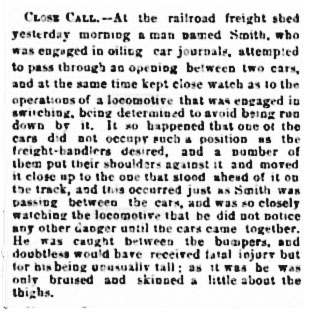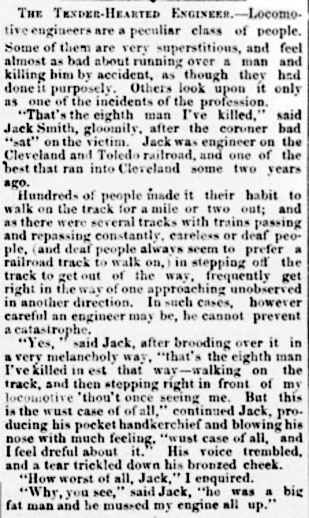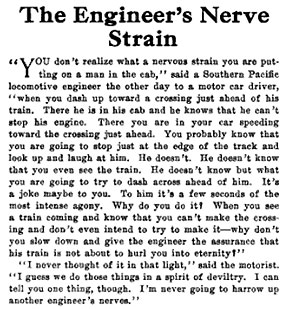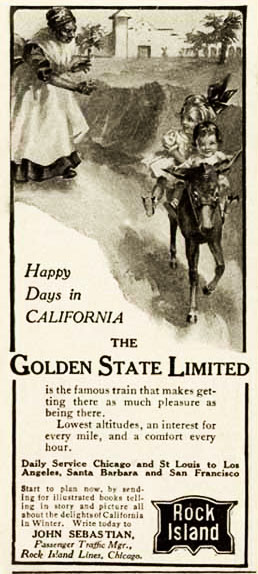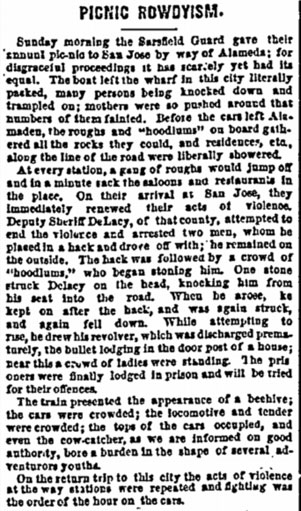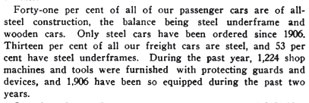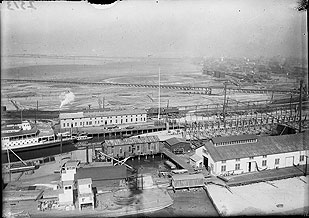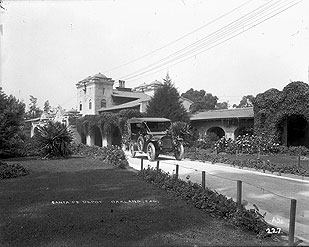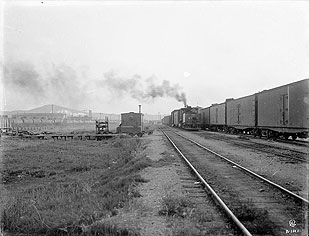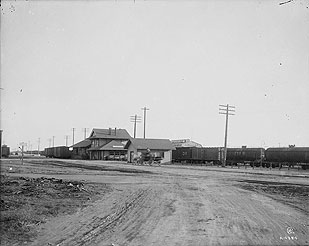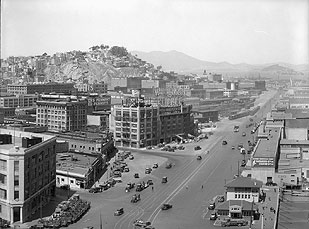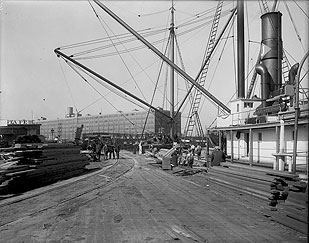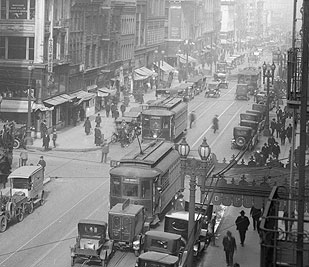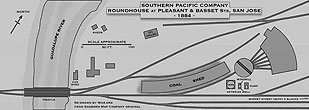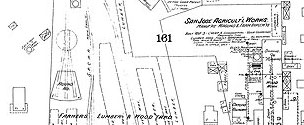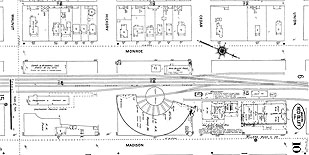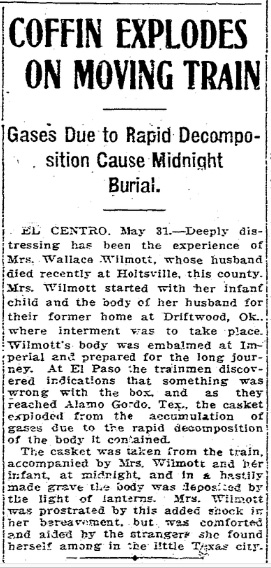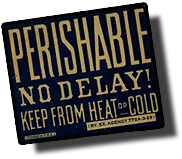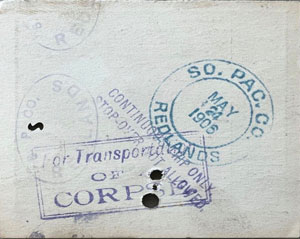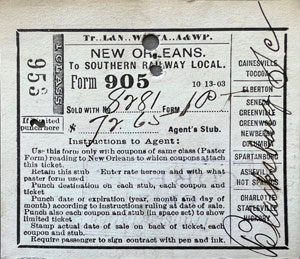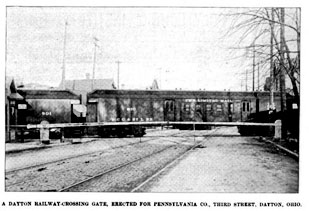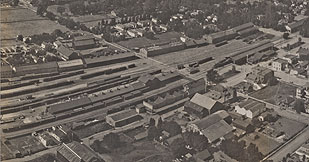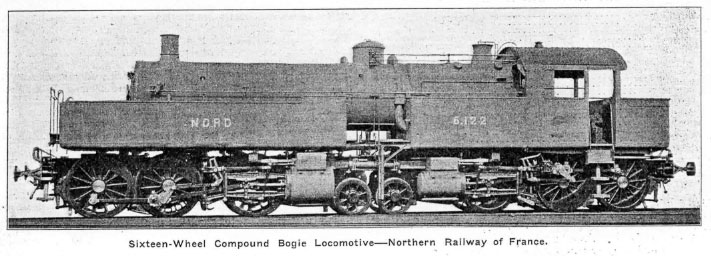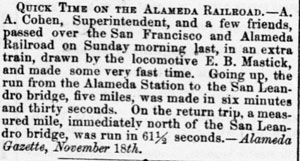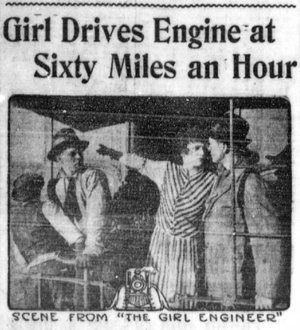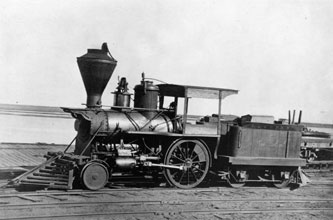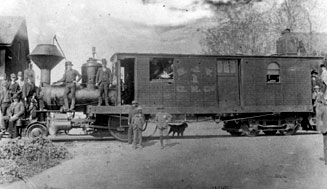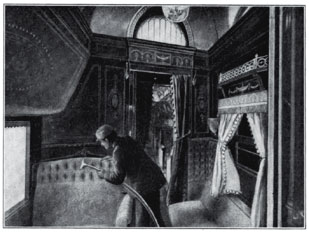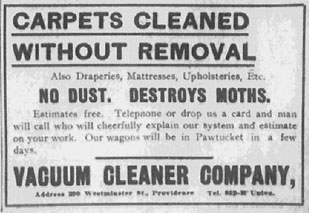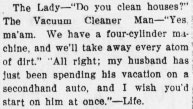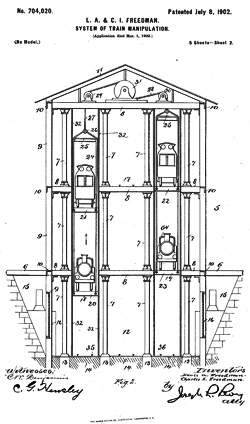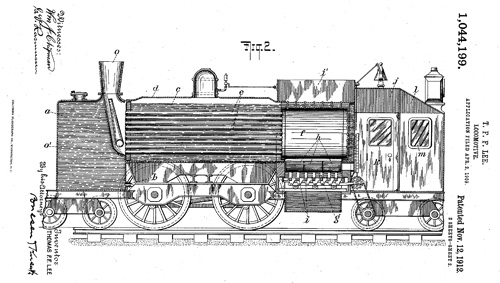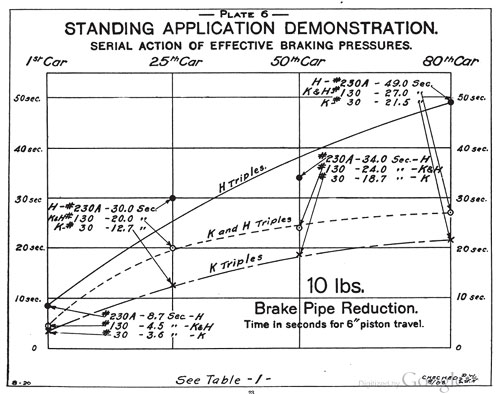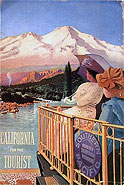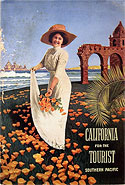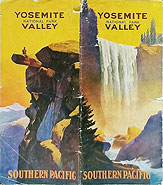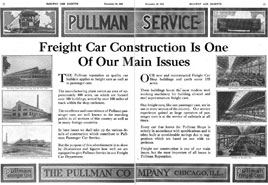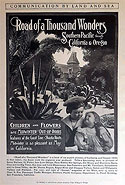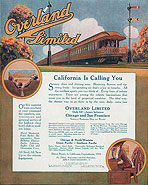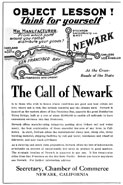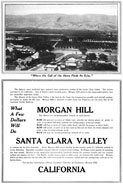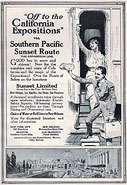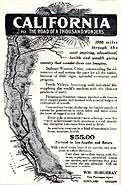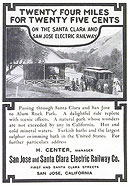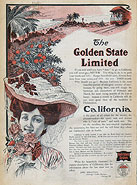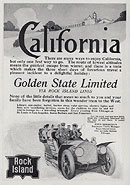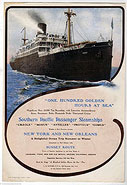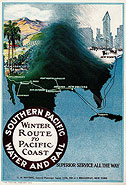|
|
last addition to this page: 9-29-22
|
|
|||
|
|
|
||||
|
After slowly declining through the 1890's, railroad accident rates took a frightful uptick after 1900, despite newly-mandated safety appliances. The first article below present's labor's view, the second, management's, followed by a fairly even-handed assessment.
above - Un-PC, gallows humor has always been the loco engineers' way of dealing with a big drawback of the job. Sacramento Daily Union, 9-1-1870
After the Civil War, some Irish Catholic vets continued military service by joining the Sarsfield Guard, a militia unit that was part of the Connecticut National Guard. This precursor to the Knights of Columbus fraternal order also had a San Francisco chapter. San Francisco Bulletin, 4-25-1871 p3 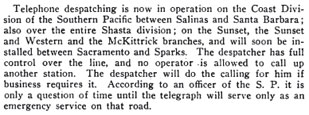 Railway Age Gazette, 1911 p. 345
A Wx4 original - SP San Jose roundhouse, 1884, redrawn from Sandborn Map Company original - It is unclear if this was constructed by San Francisco & San Jose Railroad or SP. Today's Highway 87 runs over the location. SPC 1884 San Jose roundhouse: Sanborn map company's fire insurance map shows it crammed into a corner of a wood yard, across The Alameda from today's Caltrain Depot. Red Bluff SP roundhouse, 1912; Sandborn Map Co.
(above) The job of train baggagemen, or "TBM's" as they used to be called, was not without its hidden risks. For instance, before such was banned, baggage cars transported movie film made of cellulose nitrate (a derivative of gun cotton that could burn under water) which had a nasty habit of spontaneous combustion. Luckily, no human being has ever spontaneously combusted in a baggage car as far, as we know. But again, before refrigeration and tightened regulations, a bit of warm weather in a closed baggage car was quite conducive to runaway chemical reactions in the bodies of the deceased, the net result being an explosion that might not only take out its surrounding casket, but also whomever was sitting atop it swigging on Old Crow from a hip flask. (right) This transcontinental "final journey" must have caused a bit of concern among its transporting railroads, as indicated by the stamped prohibition against a corpse stop-over.
|
I have a fascination with Turn-of-the-(20th)-Century railroading, which arose out of a long-to-materialize personal fathoming of how dynamic, revolutionary and chaotic those times were. All of a sudden, within the span of a decade, or so, much of the industry was transformed from figurative backwoods railroading into the initial stages of a modernity that survives until this day. No decade in railroad history was nearly as transformational: Financiers gave way to professional managers (see Railroaded by Richard White for an intriguing, controversial chronicle of this) and business increased in leaps and bounds, partly because the national economy was more prosperous than it had been after many years of depression and stagnation, and partly because the economies of the lately longer, heavier and faster trains allowed the railroads to stimulate new business through lower rates.
Freight trains began growing in bulk and speed nearly overnight courtesy of the Safety Appliance Acts - notably automatic couplers and air brakes - that the Federal Government contemplated as an enhancement to railroad safety. In fact, just the opposite took place for awhile. The devices enabled railroads to increase train size, speed and density so quickly that organizations, infrastructures and the workers who manned the trains - all configured for the old-style leisurely running of comparative tea-kettles - failed under the load at an alarming rate. The worst result of the chaos at trackside was an alarming increase in collisions and accidents, adding to the slaughter that seemingly always accompanied railroading (see "on railway accidents", below). Death Rode the Rails by Mark Aldrich, an absolutely requisite read for anyone surveying this period, lays the whole matter out in scholarly, yet hair-raising detail that affirms his choice of a sensationalistic title. The good works of Messrs White, Aldrich and a host of other contemporary authors make a compelling case for studying the period, but their offerings pale compared to the nearly infinite, and often primary source, material available from Google, Internet Archive and many others. It is a bit of historical irony that the details of ancient, pre-copyright railroading are more readily available than those of more contemporary times - all-the-better to explore the deep past , when everything was so different. The Past Less Traveled is a good way to begin, as it is a collection of random and juicy tidbits selected to entertain and ulimately entice folks unfamiliar with early railroading into performing explorations of their own. If the presentations here do not stimulate your intellectual curiosity, well, what's wrong with you? |
||||
|
|
|||||
|
Crossing Gates, SP 1895 Version
"Among the many appliances which inventive genius has devised in aid of safe and efficient railway service, none have recieved more generous welcome and won the appreciative recognition of railway men, than the Dayton Railway-Crossing Gate..." Crossing gates are not a new thing. It wouldn't suprise me to learn that they appeared in some form or another shortly after the very first messy & disturbing remedial cleanup of an unfortunate meeting between a train and wagon-load of pigs. The first gates undoubtedly were lowered by hand, but by the mid-1890's they were getting sophisticated, affording the option of being operated pneumatically or mechanically (possibly even electrically) from a tower or gatehouse. Turning to the article, we see that in 1895 the Craig-Reynolds Foundry Company, manufactureres of the Dayton Railway-Crossing Gate, was so euphoric about their product's superiority that they forgot to specify how it works. All that I have been able to ascertain from elsewhere is that it featured some sort of mechanical connection from a watchman-operated wheel located in the gatehouse, and that the gates pivoted on roller bearings. SP and SA&AP purchased examples, perhaps because the Dayton gates were cheaper than available automatic gates. The latter were not particularly dependable, anyway, making them a them more or less a wash with manual gates, which were heavily subject to the uneven state of their operators' sobriety. |
San Jose Depots & Freight Yard Panoramic, 1906 No edition of The past Less Traveled is complete without mention of Wx4's former headquarters city, San Jose. Here we see Southern Pacific's freight and passenger terminal in 1906, shot from a balloon by famed photographer, George R. Lawrence (he also occasionally used kites), courtesy Library of Congress. The long, rambling structure at center was SP's first depot, by then the freight house. The original structure, to the right of the gables, was opened in 1864 by the San Francisco & San Jose Railroad, to which SP made three separate additions. It was succeded by the arcade-style structure in the upper right corner, which itself was closed in 1935 in favor of a new depot located at former West San Jose, today's Caltrain station. West San Jose originally contained narrow gauge South Pacific Coast's own San Jose depot, yards and roundhouse. Hence SPC's was the "Narrow Gauge Depot" and SP's the "Broad Gauge Depot" until the SPC tracks were widened in 1907. The next year, considering the "Narrow Gauge" term anachronistic, SP officially named the location West San Jose. The SPC station likewise featured an arcade shed until SP began substituting standard gauge trains, which were too big to fit. |
||||
|
|
|||||
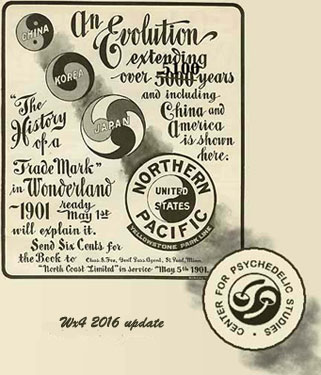 |
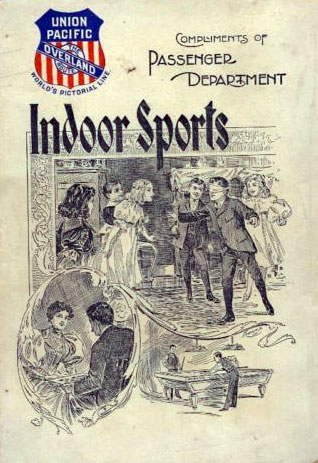 |
||||
| [left image] Nothing stays the same, except for the railroad industry's mentality, which is about as it was back in the caves. Northern Pacific would appear to have been the rare exception, judging solely upon a series of highbrow-appearing, Turn-of-the-Century "Wonderland" advertisements. In a single ad, NP suggests how much it had evolved from the caves, and likewise hinted that it had a femine side - very uplifting and very baloney. About three decades prior, NP had driven Jay Cook to ruin. In turn this caused a stock market panic and depression that caused lingering wounds lasting for the balance of the 19th Century. A decade after Cook's fall, NP drove Henry Villard to a nervous breakdown. Currently (1901), E.H. Harriman was busy with his "Northern Pacific Corner" a stock raid to wrest control of NP from Big Jim Hill, which coincidentally caused the Panic of 1901 - the first crash hosted by the New York Stock Exchange. Soon after, Hill, his backer J. Pierpont Morgan and Harriman held a grand reprochment, forming Northern Securieties, which succumbed to the Sherman Antitrust act in short order. This conduct is not what Chinese philosophers had in mind in creating the Great Monad (Ta'i Chi) as a representation of harmony in the universe, but what the heck, we'll run with NP here and even update their concept to the 21st Century. If NP was still around today, riding their trains would certainly be a far out trip, man. [right image] Our idioms have evolved considerably more than our railroads.
Jacques, the master French locomotive designer, claimed that it was a masterstroke of his |
|||||
|
|
|||||
|
Our generic perception of railroading in early times typically is of a teapot locomotive propelling a train along at 15 or 20 m.p.h., while the passengers hang on for dear life. In truth, reasonably high speeds came along quite early, apparently because life was cheaper in those days. The Sacramento Valley Railroad, for one, threw caution out the window on a couple of occasions. The Sacramento Union reported that under testing in 1856, the new 4-4-0 locomotive L.L.Robinson managed to hold onto the SV's flimsy iron rails long enough to be recorded as making 22 miles in 24.5 minutes. Historian Gerald Best maintained that stablemate C.K. Garrison, another 4-4-0, bettered that by covering 6.5 miles in six minutes.
Some historians question that a mere 2-2-0 could have achieved those dizzying speeds, pointing to the Mastick's cousin, a steam car of clumsy proportions dubbed the Flea, as the likely configuration of the Mastick during its momentous run. Luckily, what scant evidence that exists regarding the Mastick points to it as being identical to the Alameda, a lowly dock switcher at Alameda Point, negating what is an offensive notion to the sensibilities. |
advertisement for Hazards of Helen episode 23; Albuquerque Evening Herald, 4-6-1915
above: The E.B. Mastick wound up as the Los Angeles & San Pedro's San Gabriel, as seen here at the latter point in 1869; twin Alameda went to the San Rafael & San Quinton; Los Angeles County Library via Calisphere. below: This ungainly San Joaquin Valley Coal Mining Company machine is regarded by most historians to have been the former Central Pacific pay car Flea. Its likeness to Mastick is apparent. San Joaquin Couty Library System via Calisphere
|
||||
|
|
|||||
|
Part I: The Vacuum Cleaner |
|||||
|
In a peculiar way, the following should resonate with the typical young railfan, who who has better things to do than clean out the Frito crud, leaking McDonald's catsup packets and half-eaten Milky Ways from the interior crevasses of his '93 Corolla train-chaser. Living in Victorian times was grubby proposition, and a dusty one, both inside and out. These days people of computer-controlled interior environments just do not appreciate how disgusting existence could be back then, even for the well-to-do. Railroad passenger cars were a particularly bad proposition in this respect, as they sucked-in coal cinders and dust / water vapor genteelly described as "of human origin". There was no such thing as retention toilets in passenger cars in those days, and what "vapor" that did not immediately find an open window wound up coagulating/drying on the right-of-way, waiting to be repeatedly stirred up by Pullman Palace cars passing by at full chisel. Thus, it takes little effort for us to understand both the general misery involved in riding in a swirl of smoke, feces and other human detritus, along with the lingering health effects produced by these things finding their way to one's pulmonary system. Coach cleaners' tools of the remediation trade were limited in their effectiveness. Feather dusters, brooms (regular & whisk), dustpans, mops, buckets of sudsy water and dust beaters had by then shown their general lack of effectiveness since times long before railroads. Benzene was a great, augmenting leap forward when it came along, as it worked well as a degreaser of nasty goop, (not so well on the new plague of the era: chewing gum). Coincidental to the cleaning process, benzene was also was an effective generator of leukemia. Side note: Benzene's pleasant smell caused it to be widely used as an aftershave, one of many chemical reasons the US currently does not have a population of 500,000,000. But remediation of dirt and in particular, dust, was still an ongoing problem. Any porter or car attendant worth his salt knew how to configure car window openings to achieve a superiority of dust outflow over influx at any given train speed, but invariably passengers knew better, putting best employee efforts to naught. Coach cleaners had limited power over dust, as it was cumbersome to haul onboard amenities - seat cushions, mattresses and such - outside for a good beating, so such treatment occurred on a less frequent basis than the standard Saturday night bath. A fair amount of dust and other disgusting items were effectively inextricable, short of using a fire hose. Nooks and crannies everywhere successfully defied the most conscientious attempts at extraction. A whisk broom's strength lay in its ability to redistribute, rather than remove, particles of filth. The feather duster possessed no known advantages beyond making workers look busy. |
We take the vacuum for granted these days, but without it, we would still be redistributing 19th Century dust around our living spaces. Air conditioned trains, sans opening windows, would be veritable rolling incubators of lung disease. The true vacuum cleaner appeared on the scene in 1903 and caught on like wildfire. Carpet sweepers had been around for quite awhile, but received mixed reviews about their effectiveness, particularly regarding their application to curtains. One fellow almost scooped the vacuum's British inventor a full six years earlier, except that he got it exactly backwards by using compressed air to force dust into a collection chamber, a risky premise at best, even when the device was not malfunctioning. Its beauty was in its portability. All one had to do was hook it up to a portable, gas powered air compressor and take it anywhere… that a thousand pound compressor could be hauled.
By 1905, railroads were already appreciating the benefits of the newfangled device, led by Central RR of New Jersey and Delaware Lackawanna & Western, who installed Kenny Vacuum System in their Hudson River Terminals. In design, these systems resembled today's residential central vacuum setups, except in enormous Steampunk dimensions. The CNJ version at Communipaw (see illustration) featured roughly three miles of 2-5 inch piping connecting steam powered vacuum pumps of immoderate proportions to receptacles spaced every car-length, or so. Thus, instead of hauling seat cushions outside, coach cleaners were dragging maybe 75 feet of 1 ½" hose inside.
The extent of theses facilities pretty well confirms the extent of the dust and dirt problem. The Kenney System's purveyor, the self-evidently-named Vacuum Cleaner Company, unfortunately was not able to take advantage of the overnight, staggering demand for vacuums in either the industrial or consumer marketplaces. It soon became involved in patent lawsuits, which seem to have drained the company of funds better spent on R&D. Other outfits like Hoover came along with superior products that eclipsed much of their business, forcing the Vacuum Cleaner Company into receivership in 1912.
Think of this the next time you plunk yourself down in an Amtrak seat, only to discover that you are sitting on a wad of spent chewing gum. Things used to be much, much worse. |
||||
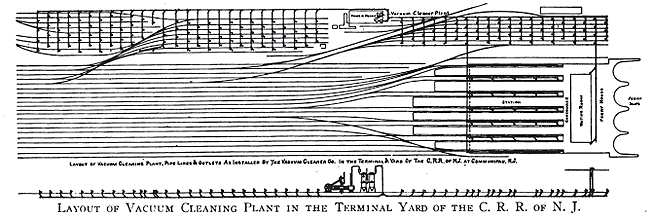
above - Kenney Vacuum System, as installed by his Vacuum Cleaner Company on CNJ at Communipaw: The dots next to the tracks at top represent hose receptacles. The extent of these facilities pretty-well confirms the extent of the dust and dirt problem.
|
|||||
 NEW 7-23 |
|||||
| A major source of both amusement and puzzlement for us is Google Patents. Although Google has lamentably left the search term "weird" off their keyword list, it does not take much time to find a host of cockeyed ideas. Here's two of our favorites. At left is Freedman's System of Train Manipulation for storing trains in tight places. We understand that California High Speed Rail has embraced the concept. At first glance below, Lee's cab forward locomotive appears to be of ancient design; reusing components from Stephenson's Rocket, but NO! It gained its patent in 1912, well after SP's "back-ups" appeared. Click on the images for PDF's. | |||||
|
|
|||||
The graphic below has caused me to lament that I never had the opportunity to talk shop with a Turn-of-the-Century engineer, say departed local celebrity Billy Jones. Oh, what a handful freight trains must have been back then… Though it is one of many graphs that appear in a 1908 SP booklet describing the results of air brake tests, this graph alone raises a great many questions about how freight trains behaved, and moreover, whether engineers truly had mastery over them in those years… or not. What we have here is a straightforward depiction of how quickly brakes set up through the length of an 80 car freight train under three scenarios: 1) equipped only with older Westinghouse style "H" triple valves, 2) equipped solely with newer K-2 triple valve systems, and 3) equipped with a combination of the two. Looking at the graph, one doesn't need to be an expert to understand that a train's-worth of K-2's causes the 80th car to set-up about twice as fast as a train using "H" models. Interestingly, a train equipped with equal numbers of K-2's and H's set up nearly as fast as the pure K-2 one. This has to do with how K-2 brakes each vented brake pipe air pressure as they set up, but this really isn't important here.
What is important is the disparity in how quickly the two types set up. Also note that the H was an improvement over earlier designs still in widespread use that were even slower to respond. AND, further note that in 1910, many freight trains still had some cars without any air brakes. Air brakes (and automatic couplers) were very gradually phased-in beginning in 1893. It wasn't until 1903 that freight trains were required to have at least 50% of their cars equipped with air brakes. In 1907 this was upped to 75%, with the inclusion that the brakes actually be operable, a glaring omission in the 1903 law of which railroads took full advantage. In the year of the tests, 85% operable brakes were specified, a figure that still stands today. Yep, all of the brakes on a train still don't have to work properly, but there are limitations about inoperative brake locations in a train.) So I ponder, what did this seemingly unholy combination of different brake types mean to an engineer, particularly in those years prior to the tesst, when K-2's were just beginning to appear. Slack action - that nominal six inches of coupler free-play per car - must have been a bugger to control even under the most favorable of circumstances. I wonder how successful even the "brake artists" (engineers known for their expertise in 'train handling', the heart of the engineer's craft) were in controlling their charges in some situations. By way of example, let's say that a fifty car train - a reasonable maximum before the K-2 found general employment - was composed of roughly 50-50 air and hand-operated brakes. Of air brakes, there were a smattering of a few K-2's spread through the train. Also, let us assume that the air brakes reflected the typical maintenance of the time, and that approximately one-fifth or less of them worked according to manufacturers' specs. (Note that several years later, after "operable" brakes were specified, ICC inspectors nevertheless found that the actual ratio was even worse than this, necessitating further regulatory clamping down upon railroad practices.) In other words, the engineer was confronted with a train whose air brakes mostly set up slowly, if at all, interspersed with a few that set up twice as fast. And then there were those 25 cars, running in and out like a Slinky toy, that were dependent upon the good services of brakemen and their clubs. In such a scenario, if the engineer set the train air, that six inches of slack per car was in position to do some real damage. If the train was in a "stretched" configuration, where the slack was fully run out and all of the couplers were pulling on each other, a mere setting of the air would cause this: the few "K" brakes would set up quickly, causing "H" brake and malfunctioning brake cars to slam into them. This would happen in several places throughout the train. And then there's those 25 cars equipped with hand brakes only - a potential giant KA-PLOWIE of slack running-in, enough to launch cars into the ditch and the conductor through the front door of the caboose. (aside: personnel at infirmaries, the ubiquitous features of railroad yards back then, were quite familiar with treating head trauma.) To avoid a giant run-in, I would think that when coming to a planned reduction in speed or stop, an engineer would whistle "down brakes" to tell the "hoboes" (brakemen) riding the top of the cars to begin clubbing-down the brakes, just as they had done for nearly three-quaters of a century. Then, when he felt the cars drag as the brakemen did their work, he would gently begin applying the air brakes in the hopes that the slack would run-in (become "bunched") gently, or preferably remain stretched. This is all well and good, but what if the engineer was unexpectedly forced to slow his train? Basically, the brakemen are of no immediate use, so even if the engineer somehow manages to keep the half of the train with air brakes stretched as he applies the air, the unbraked second half of the train is going to slam into the first half, with the resulting repercussions and concussions. Worse, if the engineer applies the emergency brake, he is virtually assured that the mid-train point of impact will settle into somebody's cow pasture or front parlor. If the train's slack was already bunched when the brakes are applied, things would have tended to work out more favorably, since the six inches of slop between cars would be largely eliminated. But, bunched slack was an uncommon normal configuration in steam loco days. The slack could have been bunched using engine/tender air brakes if there were any, or through the judicious use of the Johnson bar, but one problem with this approach was that over-use of engine brakes tended to overheat the steel tires which were force-fitted onto driving wheels. This sort of thing causes the tires to expand , lose their grip on the wheels, and fall off, an undesirable state of affairs. Another problem with bunch braking could have been that, just as with stretch braking, the disparity in brake action between H and K brakes may have caused some cars to bunch, others to stretch, thus the couplers to fail. It seems likely to me that engineers tried to keep their slack stretched in most cases, and hoped for the best. I suppose that there was also the possibility that the engineer may have been able to bunch the slack by making a quick set and release, thereby causing just a few cars on the head end to set up, but this was a risky proposition for a variety of reasons. Some of the old steam engine hogheads that trained me either never learned, or at least lived in great fear of bunch braking, the approved method in the diesel era. With diesels, dynamic brakes on the engine can be used to gently bunch up the train before an application of air. The worst time to apply the air is when it is in a state of "free" slack, wherein cars are drifting along randomly bumping into or pulling on their mates. If the air is set when the train is in this configuration even in today's times, it is bound to break into two pieces, at the very minimum. A state of free slack accentuates the differences of braking rates and forces between the individual cars. I've personally witnessed from close range what can happen when a train in free slack goes into emergency at 10 mph (the slower the speed the worse things get, because braking friction grows as speed lessens). As soon as the air went, I could see the slack sort of "shudder" as part of it ran out out to the left of my viewpoint, while the balance of it shuddered out in the opposite direction to my right. Then suddenly, the slack ran together from the opposing directions, causing the ends of two adjoining 85 foot flatcars to jump several feet into the air and form a low, graceful arch at the point of impact before crashing to earth. Given the great differences between car brakes a hundred years ago, similar incidents must have been spectacular. So, ultimately how did engineers cope with these sorts of things? We haven't even talked about how engineer's air brake control valves were evolving just as rapidly as the car brakes, or that within a decade's time, freight trains just about doubled in size, thanks to air brakes and automatic couplers. My gut feeling is that even the best engineers had only mixed success dealing with all of this. Accident statistics back this up. After declining dramatically in the 1890's, collisions and derailments shot up dramatically simultaneous with the widespread use air brakes and automatic couplers. Railroads realized that these improvements facilitated running longer, heavier and faster trains, whereas Federal authorities wrongly assumed that trains would remain small, and that these appliances would enhance safety. The engineer and his fellow crew members basically took the brunt of this wrongheaded thinking; were forced to figure out things largely on their own. The unprecedented and rapid evolution of technology and conditions was, I judge, beyond mastering 100% of the time. |
|||||
| Railroad mechanical instructors have forever talked about various "colors" of air, hence the highly colorful drawing at right of a K-2 brake cross section. Road foremen of engines and rules instructors loved this sort of thing, but your average employee, who would have been more concerned with practical functionality rather than theoretics, would have considered this graphic useful as a colorful way to cover up a hole in a wall. |
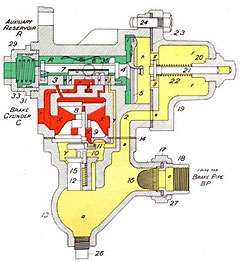 |
||||
|
High [Iron] Crimes |
|||||
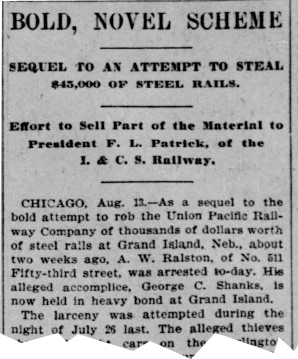
1895 - click for enlagement |
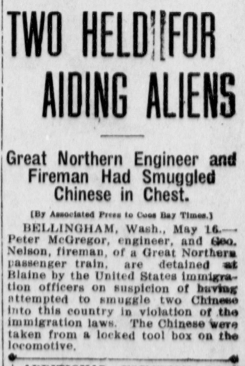 Coos Bay Times, May 16, 1914 |
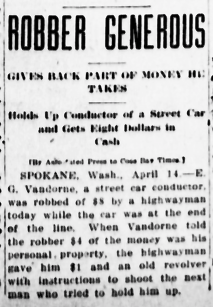 Coos Bay Times, April 14, 1916 |
|||
|
|
|||||
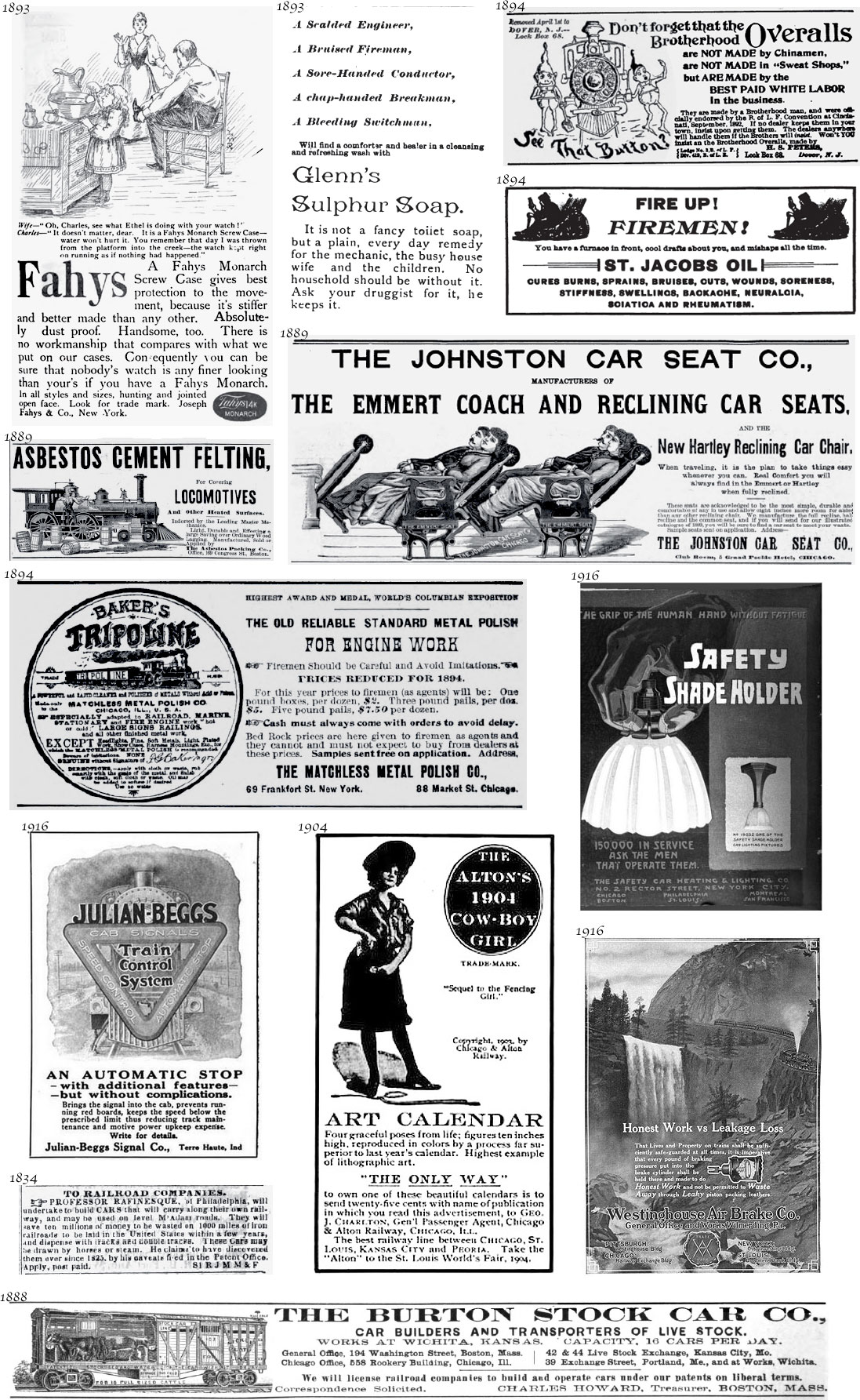 |
|||||
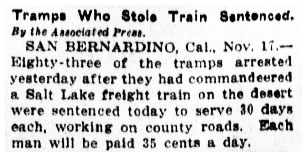 above: San Jose Mercury, 11-14-1914 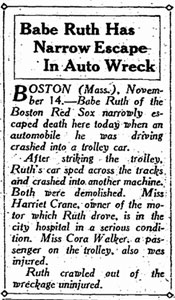 |
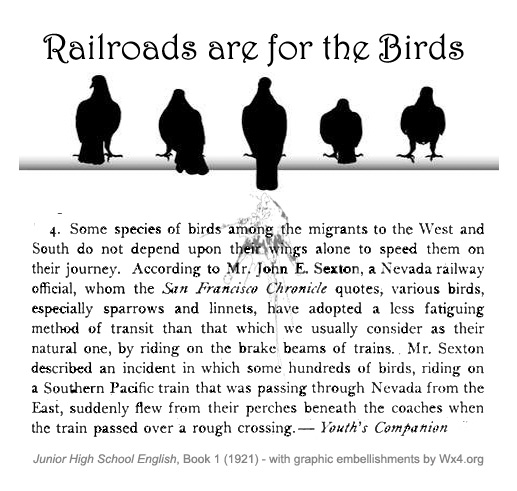 |
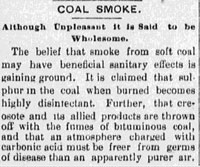 San Jose Evening News, 3-13-1890 |
|||
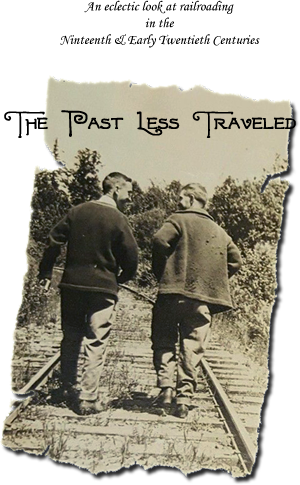
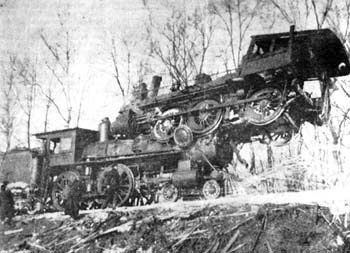
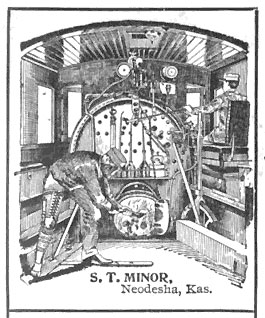
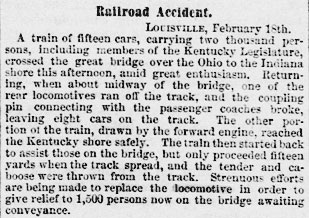 Sacramento daily Union, 2-19-1870
Sacramento daily Union, 2-19-1870